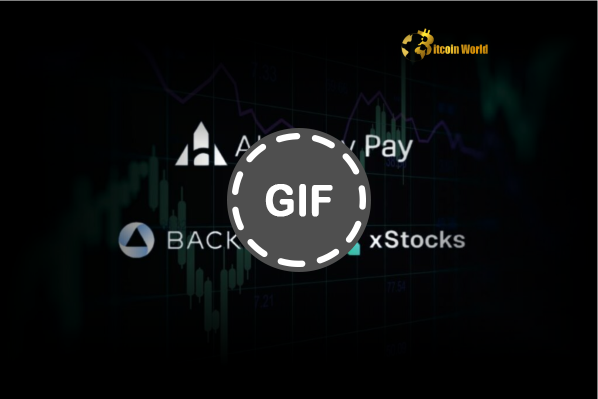BitcoinWorld

Dollar Rebound: Navigating Market Volatility Amidst Powell’s Uncertain Future
The cryptocurrency market, often seen as a rebellion against traditional finance, is nonetheless profoundly influenced by macro-economic shifts, none more so than the strength or weakness of the US Dollar. Recently, the Dollar has staged a surprising Dollar rebound, sending ripples of uncertainty across global financial markets, including digital assets. This unexpected surge, coupled with growing doubts surrounding the future leadership of Federal Reserve Chair Jerome Powell, has injected a fresh wave of market volatility, leaving investors on edge. What exactly is driving this sudden shift, and what does it mean for your portfolio?
The Surprising Dollar Rebound: What’s Behind It?
The recent Dollar rebound has caught many by surprise, especially those who had anticipated a continued weakening of the greenback. Several factors appear to be converging to fuel this resurgence. Primarily, global economic uncertainties, from geopolitical tensions to concerns about growth in other major economies, have driven investors towards the US Dollar as a traditional safe-haven asset. When the world feels unstable, the Dollar often shines as a secure place for capital.
Furthermore, stronger-than-expected economic data emerging from the United States has played a crucial role. Robust employment figures, resilient consumer spending, and manufacturing upticks suggest that the US economy might be weathering global headwinds better than initially feared. This narrative of relative strength makes US assets, and by extension the Dollar, more attractive to international investors seeking stability and potential returns.
Finally, interest rate differentials remain a key driver. While other central banks might be signaling a more dovish stance, the Federal Reserve’s commitment to tackling inflation, even if tempered, has maintained a higher yield environment for Dollar-denominated assets compared to many of its peers. This interest rate advantage provides a compelling reason for capital to flow into the US, bolstering the Dollar rebound and reinforcing its position as a preferred currency for carry trades and stable investments.
Powell’s Future: A Cloud of Uncertainty Over Federal Reserve Policy
Much of the current unease in the markets stems from speculation surrounding Powell’s future as the head of the Federal Reserve. Rumors and discussions about his potential reappointment, or lack thereof, have introduced a significant layer of uncertainty into the outlook for Federal Reserve policy. Why is this so critical? The Fed Chair’s stance on monetary policy – particularly interest rates, quantitative easing, and inflation targets – has profound implications for everything from bond yields to equity valuations, and yes, even cryptocurrency prices.
A change in leadership could signal a fundamental shift in the Fed’s approach to inflation, employment, and overall economic management. For instance, a more hawkish successor might push for higher interest rates, which could further strengthen the Dollar but potentially dampen risk appetite for assets like Bitcoin and other digital currencies. Conversely, a more dovish appointee might ease monetary policy, potentially weakening the Dollar but supporting risk assets by increasing liquidity. The lack of clarity on Powell’s future keeps investors guessing, contributing directly to market jitters and making long-term planning difficult.
The market thrives on predictability, and the current ambiguity around the top central banking role in the world’s largest economy is the antithesis of that. This uncertainty directly impacts expectations for future Federal Reserve policy, making it challenging for investors to position their portfolios effectively and leading to reactive rather than proactive trading behaviors.
Navigating the Tides of Market Volatility: What Investors Need to Know
The interplay between the Dollar rebound and the uncertainty surrounding Powell’s future has predictably led to heightened market volatility. Volatility refers to the degree of variation of a trading price series over time. In simpler terms, it means prices are swinging up and down more dramatically and frequently than usual. This environment can be both a challenge and an opportunity for investors, depending on their strategy and risk appetite.
Key drivers of current market volatility include:
- Policy Uncertainty: As discussed, the lack of clarity on the Fed’s future direction keeps markets on edge, leading to rapid re-pricing of assets as new information emerges.
- Economic Data Surprises: Strong US data can lead to rapid repricing of interest rate expectations, causing sudden shifts in currency valuations and equity markets.
- Geopolitical Events: Ongoing global tensions, conflicts, or trade disputes can trigger flight-to-safety moves, impacting currency pairs and risk assets as capital seeks refuge.
- Inflation Concerns: Persistent inflation pressures keep central banks globally on a tightening path, even if gradually, leading to rate hike expectations and currency strength, which can induce sudden market reactions.
For cryptocurrency investors, market volatility in traditional finance often spills over. A stronger Dollar can sometimes put downward pressure on Bitcoin and other digital assets, as investors might rotate out of perceived riskier assets into safer havens. However, crypto markets also have their own unique drivers, and sometimes volatility in traditional markets can push investors towards crypto as an alternative, non-correlated asset. Understanding these dynamics is crucial for making informed decisions in a fluctuating environment.
The US Dollar Outlook: What Lies Ahead?
Predicting the exact trajectory of the Dollar is challenging, but understanding the key factors influencing the US Dollar outlook can help investors prepare for various scenarios. The Dollar’s future strength will largely depend on a few critical variables that dictate global capital flows and risk perceptions:
- Inflation Trends: If US inflation remains stubbornly high, the Federal Reserve might be compelled to maintain a tighter monetary policy for longer, supporting the Dollar. Conversely, a rapid decline in inflation could give the Fed more room to ease, potentially weakening the Dollar as interest rate differentials narrow.
- Global Economic Growth: A synchronized global economic recovery, especially in major economies outside the US, could reduce the Dollar’s appeal as a safe haven, leading to its depreciation as capital flows into other growth opportunities. However, if other major economies falter, the Dollar could continue to attract capital.
- Federal Reserve Actions: The actual decisions made by the Fed regarding interest rates and its balance sheet will be paramount. Any deviation from market expectations, whether a more hawkish stance or a surprisingly dovish pivot, will significantly impact the US Dollar outlook and global asset prices.
- Geopolitical Stability: Continued global instability or new crises could trigger further safe-haven demand for the Dollar, reinforcing its strength regardless of internal US economic conditions.
The current US Dollar outlook suggests a period of continued choppiness and responsiveness to incoming data and policy signals. While the recent rebound shows its resilience and enduring appeal, the underlying uncertainties – especially regarding Fed leadership and global economic health – mean that rapid shifts are possible. Investors should remain agile and monitor these macroeconomic indicators closely to adapt their strategies.
Impact on Cryptocurrency and Global Markets: Adapting to Change
The ripple effects of a strengthening Dollar and uncertain Federal Reserve policy extend far beyond just the forex markets. For cryptocurrency investors, a robust Dollar can present both headwinds and tailwinds. Historically, a stronger Dollar has often correlated with a weaker Bitcoin, as investors seek safety in traditional assets and reduce exposure to perceived riskier ones. However, as the crypto market matures and institutional adoption grows, its correlation with traditional finance is becoming more nuanced and less predictable.
Emerging markets are particularly vulnerable to a strong Dollar. Many developing nations hold Dollar-denominated debt, and a rising Dollar makes these debts more expensive to service, potentially leading to financial instability, capital flight, and even sovereign defaults. This can, in turn, create broader global economic stress that eventually feeds back into all asset classes, including crypto, through reduced liquidity and risk aversion.
Conversely, a Dollar that is too strong can also hurt US exports, making American goods more expensive abroad and potentially dampening corporate earnings for multinational companies. This could eventually prompt the Fed to consider a more dovish stance to support economic growth, which could then reverse the Dollar’s trajectory and potentially provide a tailwind for risk assets like cryptocurrencies. Understanding these interconnected dynamics is key to navigating the current complex financial landscape.
Actionable Insights: Strategies for a Volatile Environment
In an environment marked by a surprising Dollar rebound and significant market volatility, what can investors do to protect and potentially grow their portfolios? Here are some actionable insights to consider:
- Diversify Your Portfolio: Don’t put all your eggs in one basket. Spread investments across different asset classes, including traditional stocks, bonds, and cryptocurrencies, to mitigate risk. Diversification helps cushion the impact of downturns in any single asset class.
- Stay Informed on Federal Reserve Policy: Closely follow announcements, minutes from meetings, and speeches from the Federal Reserve officials. Understanding their stance on inflation, employment, and interest rates is paramount for predicting market movements and adjusting your strategy.
- Consider Dollar-Cost Averaging: Instead of trying to time the market, invest a fixed amount regularly. This strategy helps smooth out the impact of volatility over time by averaging your purchase price, reducing the risk of buying at a peak.
- Assess Risk Tolerance: Volatility can be stressful and lead to emotional decisions. Understand your personal risk tolerance and adjust your investment strategy accordingly. Don’t invest more than you can afford to lose, especially in volatile assets.
- Look for Relative Strength: In currencies, identify which economies are showing relative strength and stability. In crypto, look for projects with strong fundamentals, clear utility, and robust development teams that can weather market downturns and emerge stronger.
- Long-Term Perspective: Short-term fluctuations are common and often noisy. A long-term investment horizon can help you ride out periods of high volatility and focus on the overall growth trajectory of your chosen assets, rather than reacting to daily price swings.
These strategies can help investors navigate the complex interplay of a strong Dollar and evolving Federal Reserve policy, turning potential challenges into opportunities for growth and stability.
Summary: Navigating the Complexities of a Shifting Financial Landscape
The recent Dollar rebound, driven by safe-haven demand, robust US economic data, and favorable interest rate differentials, has introduced a significant layer of complexity to global financial markets. This strength, combined with the profound uncertainty surrounding Powell’s future at the helm of the Federal Reserve, has amplified market volatility across all asset classes, including the dynamic world of cryptocurrencies. These interconnected forces demand careful attention from all market participants.
The evolving US Dollar outlook hinges on crucial factors like persistent inflation trends, the trajectory of global economic growth, and the precise future direction of Federal Reserve policy. While the Dollar’s resilience is evident, the underlying currents of uncertainty suggest that agility, informed decision-making, and a clear understanding of macroeconomic forces will be paramount for investors in the coming months.
As we’ve explored, understanding these macroeconomic forces is not just for forex traders; it directly impacts the performance of your crypto portfolio and broader investment strategies. By staying informed, diversifying, and adopting a long-term perspective, investors can better position themselves to navigate the challenges and opportunities presented by this fascinating and often unpredictable financial landscape, turning uncertainty into a potential advantage.
To learn more about the latest Forex market trends, explore our article on key developments shaping the US Dollar and global interest rates for future liquidity and institutional adoption.
This post Dollar Rebound: Navigating Market Volatility Amidst Powell’s Uncertain Future first appeared on BitcoinWorld and is written by Editorial Team





